NORSEPOWER: THE SAIL OF THE FUTURE
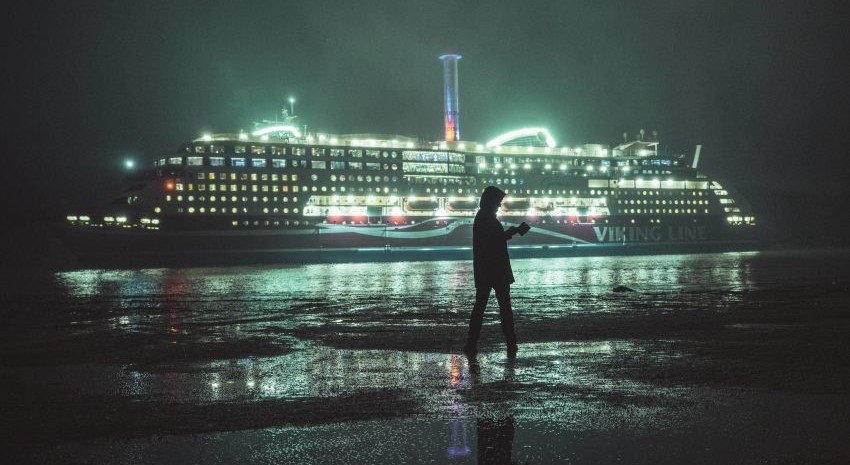
If you come across a large ship, be it a cargo ship or a cruise ship, with long cylinders towering over the deck, you might think it is some kind of funnel. Nothing could be more wrong: they are sails, huge ones, capable of moving even the largest vessels. They are at the same time the past returning, unexpected, and a great hope for the future of the seas.
Of course, they are very different from the sails we know, those born in 6000 B.C., which allowed entire civilisations to challenge the waves: Greeks, Phoenicians, Arabs, right up to the present day. Those singular cylinders, called Flettner rotors, belong to a project dating back to the early 1900s and take their name from their inventor, the German scientist Anton Flettner: even then, with his experiments, he had demonstrated that it was an invention that was a good 10 times superior to the traditional sail – both in solidity and in ability to generate thrust.
Today, these sails, developed with cutting-edge technology, are an important reality as, complementing the thrust of traditional engines, they are able to reduce energy consumption and harmful gas emissions into the environment. The rising cost of raw materials and the new sensitivity to environmental aspects have led to a serious revival of this technology, opening up a market to several manufacturers, including Norsepower Oy[1] , Magnuss[2] , Anemoi[3] , Airseas, Ecoflettner[4] , Econowind[5] , Bound4Blue[6] , and others may soon be added to the list.
Among these, Airseas is not only aiming at wind power but, by using kite-type sails, which tow the vessel, is introducing a further technological revolution[7] . For the same reasons, many activities related to maritime trade are turning towards the use of these systems, to the point of involving the interest of the giant of the skies Airbus: until now, the transport around the world of its voluminous goods, such as aeroplane parts, was entrusted to its flying giants BelugaXL, or to land transport, while in the immediate future, transport by ship is planned.
Airbus, in a landmark deal, has contracted shipowner Luis Dreyfus to manufacture, own and operate new highly efficient roll-on/roll-off cargo ships that will enter service from 2026, and the special feature of the fleet is that it will be powered by a combination of six 35-metre high Flettner rotors manufactured and installed by Norsepower Oy and two dual-fuel engines[8] , which run on marine diesel and e-methanol, a fuel produced by combining green hydrogen and captured carbon dioxide. This is expected to further reduce emissions on the global market[9] . Good for costs, better still for the environment.
The Flettner rotor and the Magnus effect.
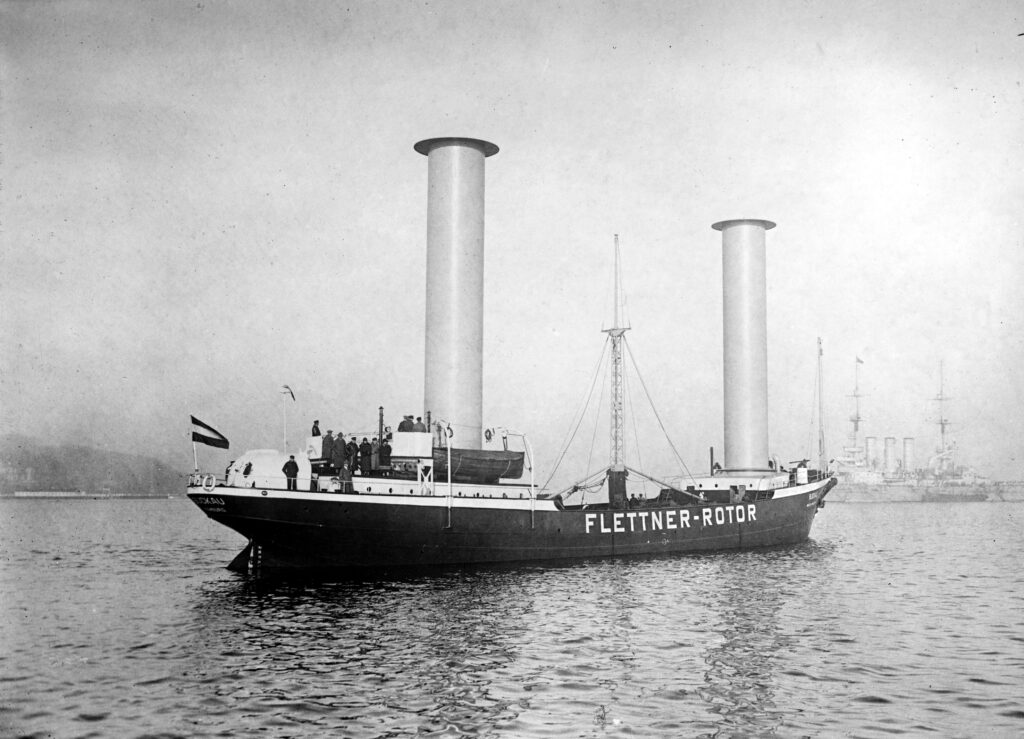
The Buckau, the first ship to house the Flettner rotor, photographed in 1924[10]
Are they really sails, even though they are cylindrical? Are they really capable of releasing the energy needed to move one of those container-laden monsters that ply the oceans? When we think of a boat, the first thing that comes to mind is that it is driven by a propeller set in motion by an engine or the wind blowing on its sails. The more astute might think of the thrust provided by a jet of water (hydrojet). Few know that there is another type of propeller that uses the wind like the sail and does so in a very unique way, through the Flettner rotor.
It all stems from the studies of the German physicist Heinrich Gustav Magnus who, in 1853, while investigating a curious effect of aerodynamics, realised that a cylindrical or spherical object, placed in rotation and moving through a fluid, receives a thrust lateral to the direction of the fluid flows. Magnus explains the phenomenon by the difference in pressure that develops on the different sides of the rotating body, which is greater on the side of the surface of the solid that goes in the opposite direction of the flows and less on the other. This difference generates a lateral thrust that starts from the region of higher pressure towards the region of lower pressure.
The phenomenon explains the behaviour we also observe in some sports, such as the effect given to a football, a golf ball or a ball (billiard, tennis or baseball) when hit at an angle: they acquire a particular rotational speed – a characteristic parabolic trajectory. Anton Flettner is an aeronautical engineer and the inventor of many technological improvements in the development of planes and helicopters, and he plans to create a nautical propulsion system using the Magnus effect. His intuition is, all in all, very simple: if you place a vertical cylinder free to rotate on a boat, if it is hit by a side wind flow, it will, due to the Magnus effect, impart a force in the rear direction that will propel the boat forward.
With the assistance of the physicists Albert Betz, Jakob Ackeret, Ludwig Prandtl and Albert Einstein[11] , in 1924 Flettner first installed two rotors on the ship Buckau, originally a 600-ton auxiliary sailing schooner built in 1920 by Friedrich Krupp Germaniawerft[12] : the two rotors, 15 metres high and 3 metres in diameter each, were powered by a 5 hp (37 kW) electric motor. After a few trials, in February 1925 the schooner set off on a voyage from Gdansk to Scotland, across the North Sea: it was a success, the rotors performing well even in stormy weather.
The Buckau, renamed Baden-Baden in honour of the German spa town, set sail on 31 March 1926 from New York for a new voyage in the direction of South America. and then turned back: the operation confirmed the many advantages of using rotors and the news was widely reported[13] . The professor of mechanical engineering at Columbia University F.O. Willhofft, in an article for the American Institute, writes enthusiastically: ‘The outstanding fact is that the rotating cylinders produce about ten times the propulsive force of canvas sails, and that the actual results obtained on the Buckau’s test voyages confirmed the laboratory results with remarkable accuracy. All that can be predicted with certainty, basing the estimate on the actual results obtained on the Buckau and the meteorological statistics, is that a motor vessel equipped with rotors will save no less than 25 per cent fuel. For him, the Flettner rotor is a decisive step forward in the exploitation of wind energy[14] .
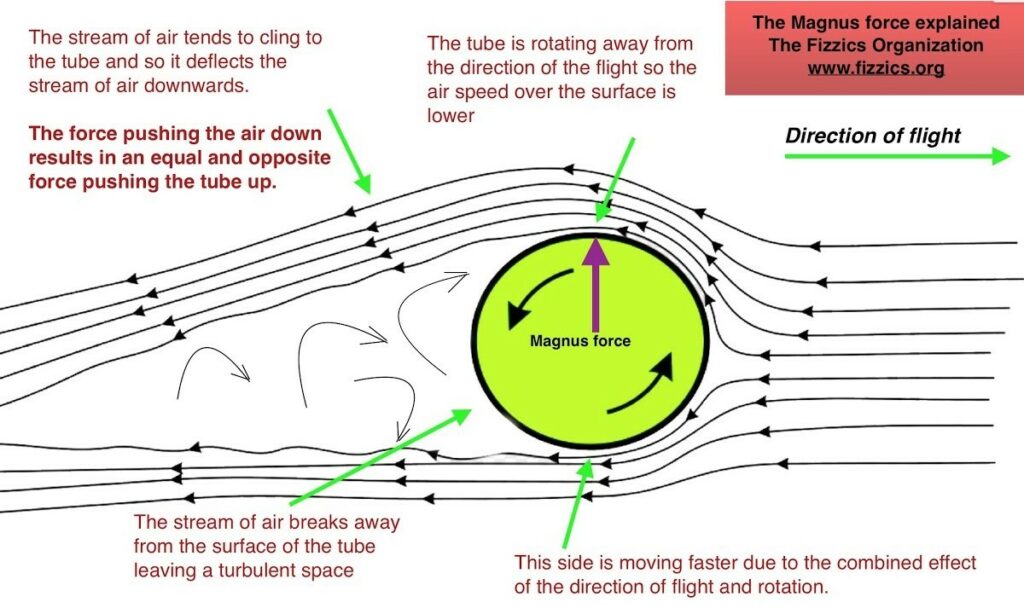
The Magnus effect, depicted with a spinning cylinder immersed in a flow of air. The upward arrow represents the resultant force[15]
The Baden-Baden was a rather small vessel and the experiment was repeated on a larger ship, the 3,000-ton ‘Barbara’, built in 1926 by the German shipyard AG Weser[16] . Despite numerous successes, Flettner had to reckon with the collapse of tariffs in the 1920s, definitely a brake on the development of new ships. It was not until the 1970s, due to the rising cost of fossil fuels and a rising environmental consciousness, that some universities resumed old studies and it was not until the end of the 20th century that anyone began to think seriously about using the Flettner rotor on modern ships.
In 1983, a Flettener turbo-sail is installed on Captain Jacques-Yves Cousteau’s ship. The test is carried out during an Atlantic crossing from Algiers to New York, and is a success. Eighteen months later it is the turn of Cousteau’s new ship, the Alcyone: equipped with two turbo-sails and a special aluminium hull, the vessel is this time fitted with a computerised system that manages the interaction between the rotors and its diesel engines with the aim of saving as much fuel as possible. The ship travels along the Americas to Cape Horn, then along the Pacific coast to the Sea of Cortez, then on to Hawaii and Alaska, but also to Papua New Guinea and Madagascar and other places around the planet. The system, with the trade name Turbosail, reveals fuel savings of up to 35%[17] .
Studies and experiments go on everywhere: in 2008, a Flettner rotor was installed on a small catamaran of just over 6 metres, the Uni-Kat, developed and built at the University of Flensburg’s Institute of Physics, with the aim of studying its behaviour as part of the PROA project[18] , which aims to apply ancient sail models, developed using the latest technology, to increase the speed and stability of small and large boats[19] .
E-Ship 1 and Viking Grace
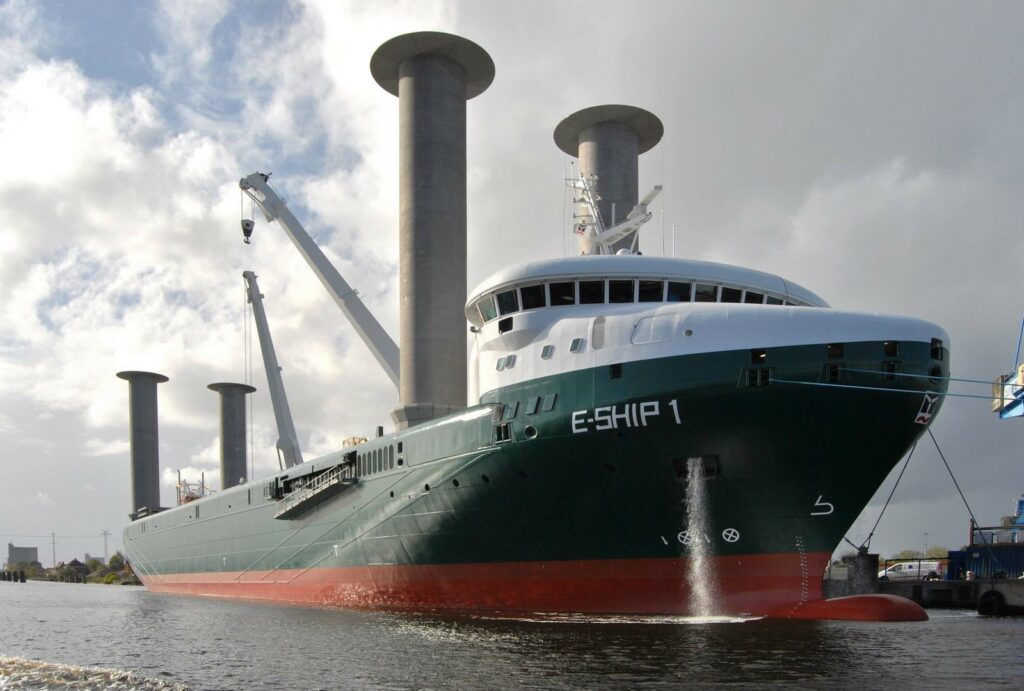
The E-Ship 1 uses four vertical sailing rotors 25 metres high and 4 metres in diameter[20]
One of the largest and most exciting examples of recent development in rotor sail technology is a roll-on/lift-off cargo ship of just under 13,000 tonnes and 130 metres in length, built by the German Lindenau GmbH Kiel shipyard, and owned by Germany’s Enercon GmbH, the world’s third largest wind turbine manufacturer. The Flettner rotor-equipped E-Ship 1, launched in 2010, is originally equipped with nine Mitsubishi diesel engines with a total output of 3.5 MW; their exhaust gases are channelled to drive a Siemens steam turbine, which in turn is used to drive no less than four 27-metre high, 4-metre diameter Flettner rotors, manufactured by Enercon[21] .
After three years of use, Nicole Fritsch-Nehring, managing director of Enercon, calls the use of rotor sails an impressive success: on 19 July 2013, data analyses are made public, the result of measurements taken during numerous voyages through various waters around the world – analyses carried out in cooperation with a project supported by the Deutsche Bundesstiftung Umwelt (DBU)[22] . After having travelled more than 170,000 nautical miles, mainly in the Baltic and Northern Seas, the Atlantic Ocean and the Mediterranean Sea, the Eship-1 achieves an average saving of 25 per cent, which translates into an annual fuel recovery of up to 1700 tonnes and a CO² emission avoidance of up to 5100 tonnes[23] .
From these results, it is assumed that, by deploying this technology, shipping companies could save up to USD 1.3 million per year on fuel costs, and if a supertanker were equipped with E-Ship 1 technology, it could save up to 9,000 tonnes of fuel and about 27,000 tonnes of CO², which corresponds to a recovery of about USD 5 million per year: very impressive numbers[24] .
By contrast, the Viking Grace is the first large passenger ferry powered by liquefied natural gas (LNG) to use a rotor sail. Launched by the Finnish company ‘Viking Line’ in 2013, a 24-metre-high, 4-metre-diameter Flettner rotor is being installed on the cruise ferry in 2018: it is a very modern version equipped with a digital control system, capable of managing activations and operating progression according to wind intensity and direction.
The new technology, which involves the hybrid use of LNG and wind power, is called Rotor Sail Solution and is developed by the Finnish company Norsepower. It is a great success story in terms of economic efficiency: after a test period that ended in April 2023, data compiled independently by ABB, Chalmers University and NAPA, as well as Norsepower itself, reveal a considerable reduction in energy consumption of between 207 and 315 kW, equivalent to 231/315 tonnes of fuel per year[25] .
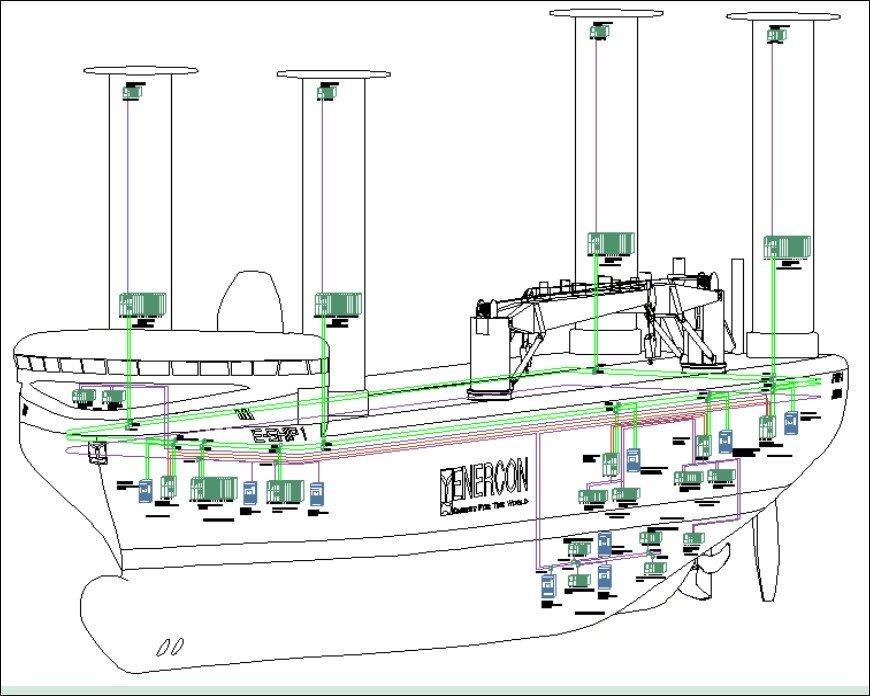
Outline of the development of centralised control technology in E-Ship 1[26]
By now, Flettner rotors are a certainty and the market opens up with sudden speed. For Norsepower it is a success and the first commercial orders arrive: it installs the wind turbine on the Maersk Pelican tanker[27] and for the first time on the vessel Sea Zhoushan, owned by Pan Ocean Ship Management and chartered by the Brazilian mining company Vale[28] . Then on the Scandlines Copenhagen ferry operating between Germany and Denmark[29] , on the K Line coal ship Corona Citrus[30] and on another coal ship, the Yodohime, owned by the Japanese Iino Kaiun Kaisha[31] .
In 2022, it signed a supply contract with Dalian Shipbuilding Industry (DSIC), China’s largest shipbuilding company, to supply sails to be installed on two aircraft carriers[32] . In August of the same year, Norsepower formed a partnership with BHP, the world’s largest mining company, and Pan Pacific Copper (PPC) of the JX Nippon Mining & Metals group, to equip their fleet with Rotor Sails. The sail propulsion system will be installed on the Koryu, a 189.95 metre long bulk carrier travelling between Chile and Japan carrying copper concentrates and sulphuric acid[33] . The wave is unstoppable.
The environmental impact of nautical fleets
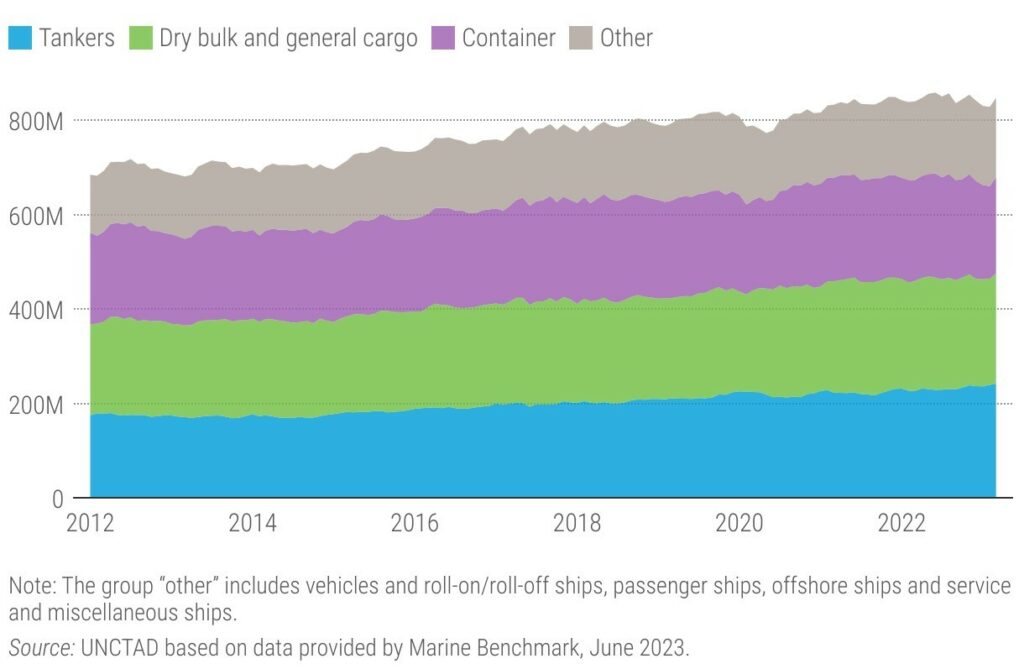
The steady growth of CO2 emissions from maritime transport (2012 to 2023)[34]
Due to growing environmental awareness, shipping is heavily under indictment as a major contributor to pollution. Over the last forty years, maritime transport has grown exponentially, from a world fleet in 1980 of 672,142 tonnes to that of 2,265,564 tonnes in 2023, forecasting a growth of more than 2% in 2024 alone[35] .
At the same time, its capacity to negatively affect the environment is growing: greenhouse gas emissions from shipping have increased by 20% in the last decade. Almost the entire fleet – 98.8% – uses only fossil fuels and is largely composed of obsolete vessels with an average age of 22.2 years – more than half of the ships are over 15 years old. According to official estimates, the sector accounts for as much as 3% of total greenhouse gas emissions, a figure that has grown by 20% in the last 10 years. By 2050, emissions could reach 130% of 2008 levels[36] .
Then there is the water pollution generated by exhaust gas purification systems that ships are equipped with. The number of ships using such systems, better known as ‘scrubbers’, has grown from just three ships in 2008 to over 4300 in 2020. Although scrubbers are effective in reducing atmospheric emissions of sulphur dioxide and other contaminants removed from exhaust gases, these agents are discharged into the sea in the form of wash water, also known as sewage. In essence, what does not end up in the atmosphere is poured into the sea. In some high-traffic maritime stretches or in shipping channels where there is little water exchange, very high toxic concentrations are reached[37] .
Such sewage is more acidic and more turbid than seawater, and its spillage contributes to ocean acidification and the general deterioration of water quality[38] . The same waters contain nitrates, PAHs (polycyclic aromatic hydrocarbons) and heavy metals, notoriously toxic and carcinogenic substances that inevitably end up in the food chain: in addition to threatening marine species, they pose a real threat to humankind[39] .
Then there is another type of pollution, too often underestimated, but no less insidious, and that is noise pollution. Generated by various activities, including military manoeuvres, oil rigs or seismic surveys, a significant part comes from commercial vessels: traction noise is the main culprit in a chain of devastating effects. The oceans are a complex ecosystem that is home to at least 230,000 different marine species.
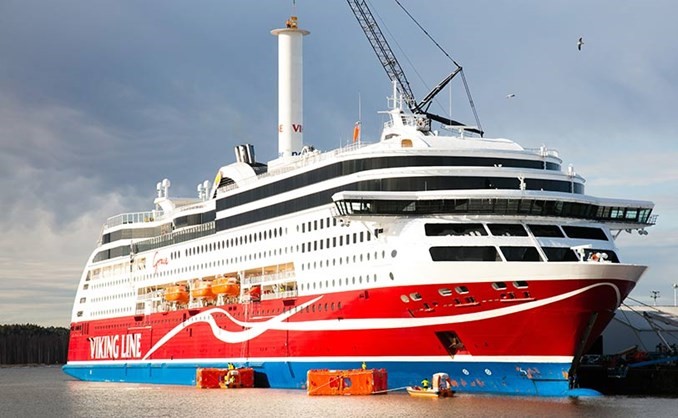
Viking Grace, an LNG ship, installing a Flettner rotor[40]
Many of these species, especially mammals (such as whales, sperm whales and dolphins) owe their existence to sound communication, and boats, mainly due to their propellers, are able to generate so much ‘noise’ that they cause great damage to their behaviour, their reproductive activities and their defence system against predators. All this results in a significant reduction in their population[41] .
But it is not only marine behaviour that suffers: a study published in 2018 reveals that fishing activities are severely diminished, even up to 80 per cent in some cases, due to the noise generated by fleets, which drives several marine species away from their natural habitat[42] .
Reversing course is an imperative
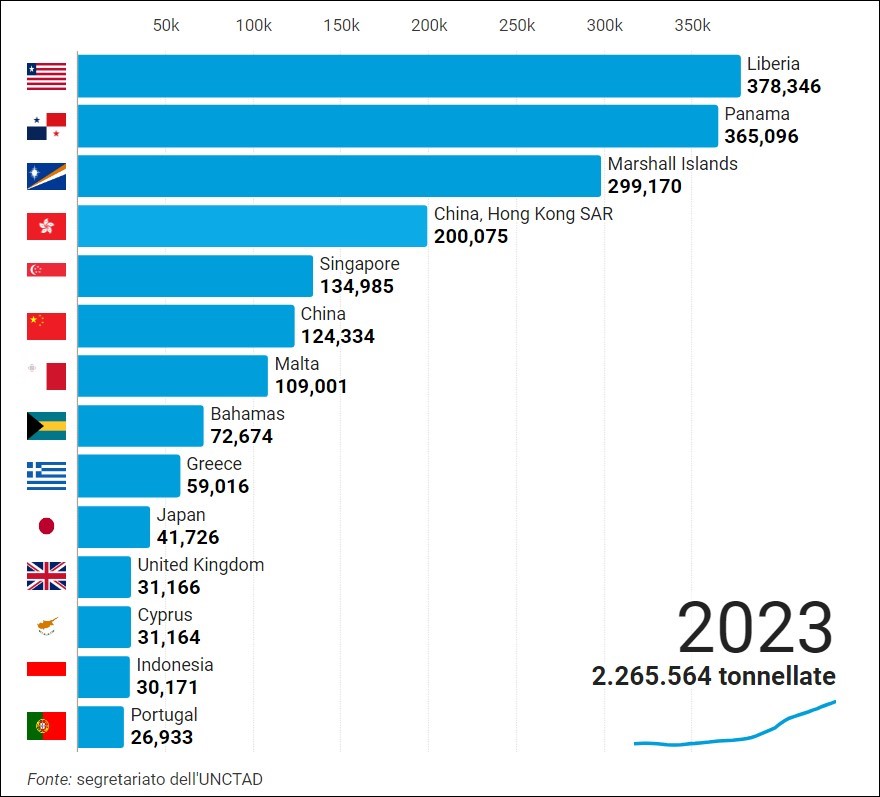
Distribution of the world fleet by nationality[43]
At certain points in history, the world’s economies have seen fuel costs rise alarmingly, and if environmental awareness were not driving the search for alternative propulsion, economic and regulatory demands certainly would. There are many innovative projects aiming at efficiency in shipping but, as is often the case, if the innovation does not coincide with a real economic gain, few companies are willing to apply it.
When one considers that out of the 2,265,564 tonnes of world fleet in circulation, almost half – or 1,042,612 – are registered in only three jurisdictions (Liberia, Panama and the Marshall Islands), places with impressive tax breaks. For these, there is little hope of participation in an effort for a ‘fair and equitable transition’ to a decarbonised maritime industry – as UNCTAD’s Maritime Transport Review Plan 2023 calls for[44] .
The burden of investing in alternative fuels, refuelling facilities and greener ships falls on ship owners, ports and the power generation industry – entities that do not consider environmental protection a primary goal. But maritime decarbonisation is a necessary step, no matter how much it costs. It is technically very complex because of the wide range of ship types and sizes, the countless structures attached to them, the large amounts of energy they use, and the global nature of maritime transport.
Technological research is pursuing several avenues, one of which is the adoption of greener fuels such as low-carbon liquid and gaseous fuels. These fuels, also referred to as sustainable marine fuels, can at least partially reduce greenhouse gas emissions compared to heavy fuel oil and other oil-based marine fuels[45] . A second avenue, still in its infancy but very promising, is the use of electric engines or their integration with classic marine engines (hybridisation).
This solution is capable of significantly reducing greenhouse gas emissions and also other dangerous pollutants such as sulphur oxide (SOx) and nitrogen oxide (NOx), which accompany the use of fossil fuels, but it will still take years of study and experimentation for this to become a real solution in large shipping[46] , although it is already a reality in the recreational sector[47] . In addition, awareness of the application of hybridisation of internal combustion engines with solid oxide fuel cells (SOFCs) is finally gaining ground[48] .
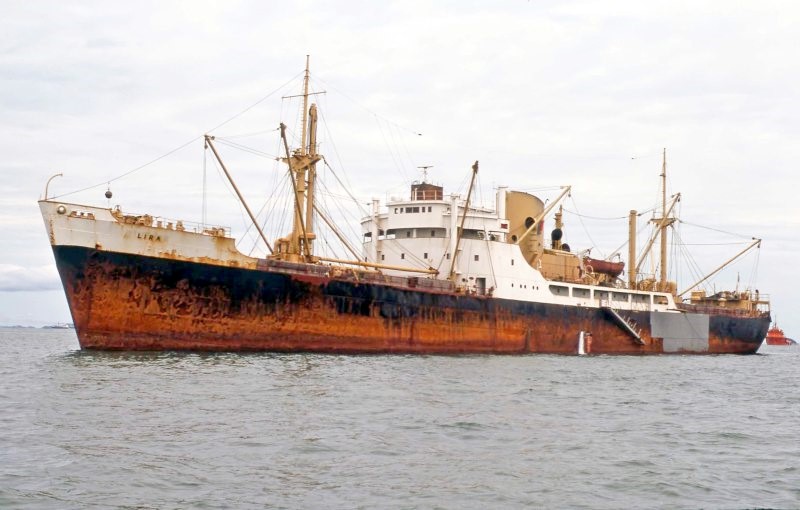
The world fleet is largely composed of vessels with an average age of 22.2 years[49]
The third way is the use of wind energy: the idea of integrating traditional propulsion with the use of sails even on transport vessels has always aroused great fascination[50] (there are promoting associations such as the International Windship Association[51] ), but the bulkiness of classic sail structures makes their use difficult, if not impossible, on vessels where cargo spaces must be free of obstacles to facilitate logistical activities. In this, Flettner rotors represent a valid alternative, both because of their special structure (they develop their surface area in height and therefore take up little space) and because they are so easy to use. In the most advanced models, as in the solution adopted by Anemoi, their installation on tracks[52] makes it possible to move them in just a few minutes to remote areas of the ship so as to facilitate loading and unloading operations without any interference.
A fourth avenue concerns energy efficiency and optimisation, i.e. obtaining the maximum amount of energy by minimising losses during its conversion and use. This is done by recovering waste heat, optimising the design of equipment, the ship’s auxiliary machinery and on-board energy management systems. Added to this is an area that deals with exhaust gas treatment, which studies techniques for energy recovery, pollutant emission abatement and carbon capture and recovery.
It is clear that technology can do much to improve a seemingly compromised situation. At the end of July 2023, at the proposal of the Member States of the IMO, the International Maritime Organisation, which launched a proposal called IMO 2023[53] , the Council of the European Union launched a new regulation to decarbonise the maritime sector: the initiative, named FuelEU Maritime, is part of the ‘Fit For 55%’ package, the plan that aims to enable the European Union to reduce its net greenhouse gas emissions by at least 55% by 2030 compared to 1990 levels and to achieve climate neutrality by 2050.
The new maritime regulation comes into force on 1 January 2025 and contains numerous provisions ranging from encouraging the use of renewable fuels of non-biological origin (RFNBO) to the elimination of fossil fuels from the certification process; from the obligation to adopt behaviours aimed at optimising the use of renewable energy, to the implementation of organisational procedures aimed at optimising processes in various areas. The proceeds of economic penalties resulting from the non-implementation of the regulation will be used for projects supporting the decarbonisation of the maritime sector[54] .

IMO Members of the Marine Environment Protection Committee (MEPC 80)[55]
There is great excitement around the call for regulations to push the sector towards sustainability, but the EU resolution is worrying. There is a risk that the high costs and complexity of implementing regulations will create serious imbalances in international competition. In September 2023, the United Nations Conference on Trade and Development (UNCTAD) published the ‘Review of Maritime Transport 2023’[56] calling for ‘a fair and equitable transition to a decarbonised maritime industry’ and highlighting ‘the urgent need for cleaner fuels, digital solutions and a fair transition to combat continuing carbon emissions and regulatory uncertainty in the shipping sector’.
It is an authoritative voice trying to shake up an industry in total stalemate. UNCTAD warns that the costs of decarbonisation are rising and the transition entails substantial costs: ‘An additional $8-28 billion per year will be needed to decarbonise ships by 2050, and even more substantial investments, ranging from $28 billion to $90 billion per year, will be required to develop infrastructure for 100 per cent zero-carbon fuels by 2050. Full decarbonisation could increase annual fuel expenditures from 70 per cent to 100 per cent, potentially affecting small island developing states and LDCs that are heavily dependent on shipping’[57] . Therefore, to ensure an equitable transition, UNCTAD calls for ‘a universal regulatory framework applicable to all ships, regardless of flag of registration, ownership or areas of operation, thus avoiding a two-speed decarbonisation process and maintaining a level playing field’[58] .
Flettner rotor goes ‘full throttle’
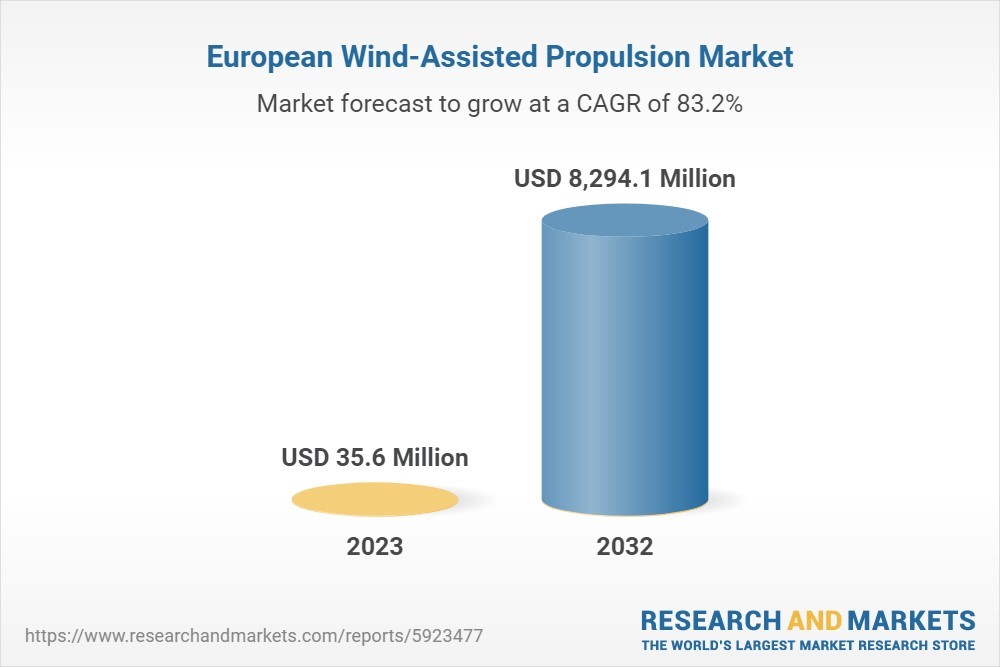
Research and Markets’ forecasts for the marine wind propulsion market[59]
With this in mind, the Flettner rotor may not be the panacea for all ills, but it does have advantages that are well known even to large boat owners. The device is simple, functional, reliable, low maintenance, relatively inexpensive, easy to implement on any type of offshore vessel and adaptable to existing vessels. As it has a great capacity to generate value, it has all the credentials to soon become a standard, especially in the cargo sector. According to Research And Markets, the marine wind propulsion market in Europe alone is expected to reach $8294.1 million by 2032 (currently $35.6 million per year), growing by 83.22% between 2023 and 2032[60] . These are staggering numbers.
Driven in part by the new decarbonisation directives, the market is flying, and Norsepower and Anemoi are leading the way, although it is the former that is leading the way. Founded in 2012, the Finnish start-up immediately attracted a lot of funding for its wind rotor project: in 2016 it obtained EUR 2.6 million in funding from the European Community and Tekes (the Finnish government agency for innovation)[61] . In 2017 it gets 1.6 million from the European Innovation Council. In 2018, it collects 3.6 million from Korkia, a well-known Finnish investor in the renewable energy sector[62] ; in 2019, 8.8 million arrives from Climate Investment. In 2023, after receiving EUR 10 million from the Finnish Climate Found[63] , it raises a further EUR 28 million through the private equity fund Mirova Environment Acceleration Capital of the French investment manager Mirova[64] . In addition to this, from 2016 to date Norsepower has collected more than USD 52 million from investors[65] .
The investment pays off handsomely as the many companies that rely on the company are appreciative. Tuomas Riski, the 45-year-old CEO and founder of Norsepower, a young physics graduate from Aalto University, says that he has always had the protection of the planet at heart and has made it his mission to reduce the environmental impact of shipping. In an interview, he explains that if every ship in existence were fitted with rotor sails, this would be the equivalent of taking 30 million cars off the roads, saving around 82 million tonnes of carbon each year.
His reference is Bill Gates, an entrepreneur who spends billions of his own money to bring about inescapable changes[66] . Riski says he had not imagined that the shipping world would be so conservative – but he is conquering it, winning contracts that were unthinkable until recently, aiming to achieve a turnover of at least 100 million euros in 2025[67] . It recognises, however, that the road will not be easy: half of all merchant ships are produced in China, a market that is certainly not easy, but that is exactly the direction Norsepower has already taken, building subsidiaries in Hong Kong and Yancheng.
Like a fairy tale: technology seems to have found a sure way to contribute to environmental improvement – a way that everyone seems to gain from: manufacturers, investors, customers, the planet. No limits, no contraindications, no side effects. And we are clearly not the only ones who think so, given the enormous planetary success of these rotorcraft sails. For once, all that remains for us to do is to observe complacently what is happening: in a difficult phase such as the current one, we have a duty to roll out the red carpet to good news.
SVE008
[1] https://www.norsepower.com/
[4] https://www.ecoflettner.de/
[8] https://www.offshore-energy.biz/norsepower-to-fit-rotor-sails-on-low-emission-roro-fleet-chartered-by-airbus/
[9] https://www.airbus.com/en/newsroom/stories/2023-10-building-a-lower-emission-maritime-transport-fleet
[10] https://www.hrmm.org/history-blog/sail-freighter-friday-rotor-ship-buckau-1925
[11] http://www.thiiink.com/history-of-flettner-rotor/
[12] https://www.hrmm.org/history-blog/sail-freighter-friday-rotor-ship-buckau-1925
[13] https://books.google.it/books?id=W99NAAAAMAAJ&redir_esc=y ‘The Story of the Rotor’ – Anton Flettener – F.O. Willhofft, 1926
[14] https://www.nytimes.com/1925/05/03/archives/sees-in-rotor-idea-vast-fuel-saving-prof-willhofft-predicts-the.html?scp=2&sq=Buckau%2520rotor%2520ship&st=cse
[15] https://www.youtube.com/watch?app=desktop&v=O6JdMSpiIqU
[16] https://www.bluebird-electric.net/ship_boat_design_building/monorotor_wind_assisted_ship_propulsion.htm
[17] https://web.archive.org/web/20170201130115/http://www.cousteau.org/who/more-vessels/
[18] https://www.slideserve.com/bailey/proa
[19] https://www.uni-flensburg.de/physik/forschung/energie/der-unikat-boot-mit-flettner-rotor
[20] https://boats.drivemag.com/features/the-return-of-rotor-sail-ships-e-ship-1-harnessing-the-power-of-wind/
[21] https://www.stg-online.org/onTEAM/shipefficiency/programm/06-STG_Ship_Efficiency_2013_100913_Paper.pdf
[22] https://w3.windfair.net/wind-energy/news/13639-product-pick-of-the-week-enercon-s-rotor-sail-ship-e-ship-1-saves-up-to-25-fuel
[23] https://translate.google.com/?sl=auto&tl=it&text=4%20%20th%20Conference%20on%20Ship%20Efficiency%20%20Hamburg%2C%2023-24.%20September%202013&op=translate 4th Conference on Ship Efficiency Hamburg, 23-24. September 2013
[24] https://w3.windfair.net/wind-energy/news/13639-product-pick-of-the-week-enercon-s-rotor-sail-ship-e-ship-1-saves-up-to-25-fuel
[25] https://gcaptain.com/ms-viking-grace-completes-rotor-sail-testing/
[26] https://www.stg-online.org/onTEAM/shipefficiency/programm/06-STG_Ship_Efficiency_2013_100913_Paper.pdf
[27] https://www.marinelink.com/news/maersk-sells-tanker-equipped-rotor-sails-484789
[28] https://www.farodiroma.it/cina-newbuild-vale-vloc-nuovo-portarinfuse-con-cinque-nuove-vele-a-rotore-inclinabile-di-a-martinengo/
[29] https://stateofgreen.com/en/news/scandlines-installs-norsepowers-rotor-sail-solution-on-board-hybrid-ferry/
[30] https://splash247.com/k-line-swoops-for-seawings-kite-system/
[31] https://splash247.com/iino-lines-to-install-norsepower-rotor-sails-on-coal-carrier/
[32] https://www.ship-technology.com/news/norsepower-rotor-sails-dalian-shipbuilding/
[33] https://www.marinelink.com/news/combi-carrier-koryu-set-rotor-sail-498648
[34] – https://unctad.org/publication/review-maritimetransport-2023
[35] https://unctad.org/publication/review-maritime-transport-2023
[36] https://unctad.org/publication/review-maritime-transport-2023
[37] https://theicct.org/publication/air-emissions-and-water-pollution-discharges-from-ships-with-scrubbers/
[38] https://theicct.org/publication/air-emissions-and-water-pollution-discharges-from-ships-with-scrubbers/
[39] https://theicct.org/publication/air-emissions-and-water-pollution-discharges-from-ships-with-scrubbers/
[40] https://gcaptain.com/ms-viking-grace-completes-rotor-sail-testing/
[41] https://escholarship.org/uc/item/11m5g19h
[42] https://www.oceancare.org/wp-content/uploads/2022/05/Underwater-Noise-Pollution_Impact-on-fish-and-invertebrates_Report_OceanCare_EN_36p_2018.pdf
[43] https://unctad.org/publication/review-maritime-transport-2023
[44] https://unctad.org/publication/review-maritime-transport-2023
[45] https://www.energy.gov/eere/bioenergy/sustainable-marine-fuels#:~:text=Sustainable%20marine%20fuels%20are%20a%20reliable%20solution%20for%20improving%20air,Sulfur%20oxide
[46] https://www.marinelink.com/news/propulsion-tech-hybridization-468308
[47] https://www.phase.eu/applications/hybrid-electric-motor-systems-for-marine-propulsion/
[48] https://www.polito.it/ateneo/comunicazione-e-ufficio-stampa/poliflash/navigando-verso-la-decarbonizzazione-del-settore-marittimo
[49] https://www.shipspotting.com/photos/3397570
[50] https://blog.naver.com/dsjang650628/220679243153
[51] https://www.wind-ship.org/en/grid-homepage/
[52] https://youtu.be/X8xysiW4S9Y
[53] https://www.themeditelegraph.com/it/markets/2023/07/07/news/mobilita_dallorganizzazione_marittima_internazionale_la_nuova_strategia_per_ridurre_le_emissioni_marittime-12929091/
[54] https://www.consilium.europa.eu/en/press/press-releases/2023/07/25/fueleu-maritime-initiative-council-adopts-new-law-to-decarbonise-the-maritime-sector/
[55] https://esgnews.it/environmental/trasporto-marittimo-adottata-una-nuova-strategia-di-riduzione-delle-emissioni-ghg/
[56] https://unctad.org/publication/review-maritime-transport-2023
[57] https://greenreport.it/news/inquinamenti/unazione-globale-coraggiosa-per-decarbonizzare-il-trasporto-marittimo-e-garantire-una-transizione-giusta/
[58] https://greenreport.it/news/inquinamenti/unazione-globale-coraggiosa-per-decarbonizzare-il-trasporto-marittimo-e-garantire-una-transizione-giusta/
[59] https://www.researchandmarkets.com/reports/5923477/europe-wind-assisted-propulsion-market-analysis?utm_source=BW&utm_medium=PressRelease&utm_code=bfbn9s&utm_campaign=1932697+-+Europe+Wind-assisted+Propulsion+Market+Analysis+and+Forecast+Report+2023%3a+Market+to+Grow+at+a+Staggering+CAGR+of+83.22%25+to+2032+with+Econowind%2c+Airseas%2c+Norsepower%2c+and+bound4blue+Dominating&utm_exec=chdomspi
[60] https://www.researchandmarkets.com/reports/5923477/europe-wind-assisted-propulsion-market-analysis?utm_source=BW&utm_medium=PressRelease&utm_code=bfbn9s&utm_campaign=1932697+-+Europe+Wind-assisted+Propulsion+Market+Analysis+and+Forecast+Report+2023%3a+Market+to+Grow+at+a+Staggering+CAGR+of+83.22%25+to+2032+with+Econowind%2c+Airseas%2c+Norsepower%2c+and+bound4blue+Dominating&utm_exec=chdomspi
[61] https://www.norsepower.com/post/norsepower-receives-eur2-6m-funding-to-develop-the-worlds-largest-rotor-sail/
[62] https://www.eu-startups.com/2018/11/norsepower-raises-funding/
[63] https://www.norsepower.com/post/climate-fund-invests-e10-million-in-norsepower-for-accelerating-emissions-reductions-in-shipping/
[64] https://www.offshore-energy.biz/norsepower-nets-e28m-in-funding-to-boost-production-of-rotor-sails/
[65] https://app.dealroom.co/companies/norsepower_oy_ltd
[66] https://medium.com/authority-magazine/green-tech-tuomas-riski-on-how-norsepowers-technology-will-make-an-important-positive-impact-on-906633f6c30f
[67] https://navigatormagazine.fi/uutiset/meriteollisuus/norsepowerin-tuomas-riski-kymmenen-vuoden-ponnistelut-toivat-johtavan-globaalin-markkina-aseman/




Leave a Reply